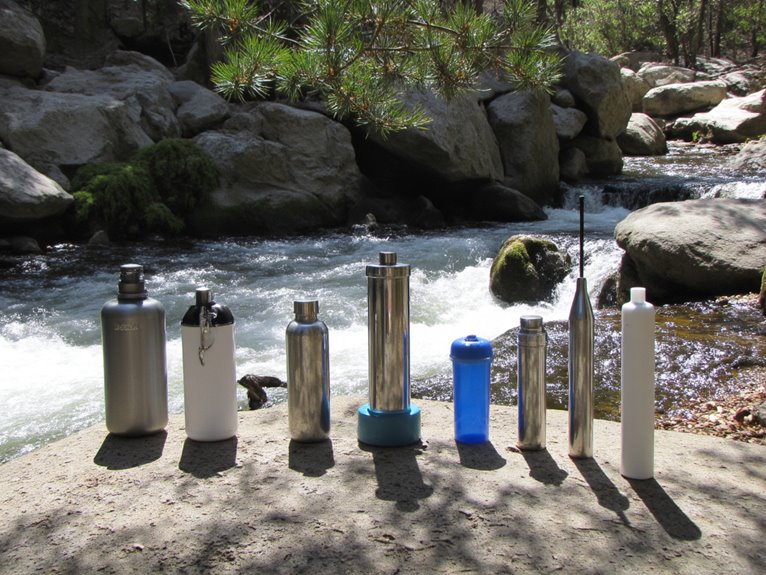Is Freeze-Drying Worth It?
Freeze-drying offers a multitude of benefits that make it a highly valuable preservation method for outdoor enthusiasts and health-conscious individuals alike. It excels at retaining nutritional value, extending shelf life, and minimizing storage requirements. Freeze-dried foods are rich in antioxidants, fiber, and beneficial compounds, making them a healthy and convenient option. Additionally, freeze-drying reduces weight and volume, making it ideal for backpackers and outdoor enthusiasts. With its numerous advantages, freeze-drying is a worthwhile investment for those seeking peak nutrition, convenience, and sustainability. There's more to uncover about the benefits of freeze-drying, and exploring further will reveal its full potential.
We are supported by our audience. When you purchase through links on our site, we may earn an affiliate commission, at no extra cost for you. Learn more. Last update on 23rd December 2025 / Images from Amazon Product Advertising API.
Preserving Nutrition Through Freeze-Drying
Freeze-drying, a preservation method that has gained popularity among outdoor enthusiasts and health-conscious individuals, excels at retaining the nutritional value of food, largely due to its unique ability to remove moisture without exposing the food to high temperatures.
This process helps preserve the delicate nutrients found in fruits, vegetables, and meats, making it an ideal choice for those seeking to maintain peak nutrition.
Unlike other preservation methods, freeze-drying prevents the degradation of essential vitamins and minerals, ensuring that the food remains nutrient-dense.
As a result, freeze-dried foods are rich in antioxidants, fiber, and other beneficial compounds, making them a healthy and convenient option for outdoor enthusiasts and health-conscious individuals alike who want to maintain a balanced diet.
Shelf Life and Storage Benefits
In the realm of preserving food, one of the most significant advantages of freeze-drying is its ability to extend shelf life while minimizing storage requirements.
By removing the water content from food, freeze-dried products can be safely stored for extended periods without refrigeration, making them ideal for outdoor enthusiasts, emergency supplies, and long-term food storage.
This innovative preservation method also allows for a significant reduction in storage space, making it a convenient option for those with limited room.
Long-Term Food Storage
Properly stored, freeze-dried meals can remain safely consumable for up to 25 years or more, making them an ideal choice for long-term food storage.
This extended shelf life is due to the removal of moisture, preventing bacterial growth and spoilage.
Freeze-dried foods can be safely stored at room temperature, eliminating the need for refrigeration or freezing. This makes them perfect for emergency supply kits, camping trips, or backcountry adventures.
With proper storage, freeze-dried meals can withstand extreme temperatures, humidity, and environmental conditions, ensuring a reliable food source in any situation.
Reduced Storage Space
Compact storage is a significant advantage of freeze-dried meals, as they occupy up to 75% less space than their fresh or canned counterparts, making them ideal for backpackers, campers, and emergency preparedness enthusiasts.
This reduced storage requirement allows for more efficient use of space, making it perfect for outdoor enthusiasts who need to carry their supplies over long distances.
Freeze-dried meals are also incredibly lightweight, making them easy to transport and store.
In emergency preparedness scenarios, this reduced storage space translates to more supplies that can be stored in a smaller area, increasing overall preparedness.
Zero Moisture Content
By eliminating moisture content, freeze-dried meals achieve an unparalleled level of shelf stability, allowing them to remain safely storable for extended periods without refrigeration.
This is particularly essential for outdoor enthusiasts and emergency preparedness, where access to refrigeration may be limited.
With zero moisture content, the growth of bacteria and mold is halted, ensuring the meal remains safe to consume.
Additionally, freeze-dried meals can be stored at room temperature, eliminating the need for costly refrigeration units or ice packs.
This convenience factor is a significant benefit, especially for backpackers, campers, and those living off the grid.
With a longer shelf life, you can stockpile meals for future use, providing peace of mind and flexibility in your outdoor pursuits.
Weight and Space Savings
Eliminating water content through freeze-drying substantially reduces the weight and volume of food, making it an ideal method for backpackers and outdoor enthusiasts who require lightweight and compact provisions.
This significant reduction in weight and volume allows for more efficient packing, freeing up valuable space in backpacks for other essential gear.
Freeze-dried meals are also less bulky, making them easier to store and transport.
For example, a freeze-dried meal can weigh as little as 1/10th the weight of its fresh counterpart.
This weight and space savings can be a game-changer for those setting out on multi-day excursions or thru-hikes, where every ounce and inch counts.
Cost Comparison to Canning
While canning remains a popular method for preserving food, the cost comparison to freeze-drying reveals significant advantages, particularly for backpackers and outdoor enthusiasts.
Freeze-dried meals are often more expensive upfront, but they last longer and are lighter, making them a more cost-effective option in the long run.
A single can of food can weigh up to 1.5 pounds, whereas freeze-dried meals can weigh as little as 3 ounces.
When factoring in the cost of transportation and storage, freeze-drying becomes a more economical choice.
Additionally, freeze-dried meals have a longer shelf life, reducing food waste and the need for frequent resupply.
For those who venture into the wilderness frequently, freeze-drying's cost benefits become increasingly apparent.
Impact on Flavor and Texture
Freeze-drying's preservation process helps retain the natural flavors and textures of ingredients, allowing for a more authentic culinary experience in the wilderness. This is particularly important for outdoor enthusiasts who crave a taste of home-cooked meals while exploring the great outdoors.
Unlike canning, which can result in a soft, mushy texture, freeze-drying preserves the crunchy texture of fresh vegetables and fruits.
Intense flavors: Freeze-drying helps lock in the natural flavors of ingredients, making meals more flavorful and aromatic.
Crunchy textures: Freeze-dried fruits and vegetables retain their crunchy texture, providing a satisfying snack or side dish.
Vibrant colors: Freeze-dried ingredients preserve their vibrant colors, making meals more visually appealing.
Authentic taste: Freeze-dried meals taste more like homemade, giving outdoor enthusiasts a taste of comfort in the wilderness.
Environmental Impact of Freeze-Drying
In terms of the environmental impact of freeze-drying, there are several key benefits that deserve attention.
By reducing water usage and increasing energy efficiency, freeze-drying offers a more sustainable approach to food preservation.
Additionally, the carbon footprint of freeze-drying is notably lower than traditional preservation methods, making it a more eco-friendly choice.
Water Usage Reduction
Freeze-drying, also known as lyophilization, is a water-efficient method of food preservation. By removing the water content from food, we reduce the risk of water-borne contaminants and minimize the energy needed for storage and transportation.
Up to 90% water reduction: Freeze-drying removes the majority of water from food, resulting in a substantial decrease in water usage.
Less water for farming: By preserving food through freeze-drying, we reduce the need for irrigation and other water-intensive farming practices.
Conservation of aquatic ecosystems: By reducing our water footprint, we help protect aquatic ecosystems and preserve biodiversity.
Supports sustainable agriculture: Freeze-drying promotes sustainable agriculture by reducing the environmental impact of food production and distribution.
Energy Efficiency Gains
Beyond conserving water, the freeze-drying process also offers significant energy efficiency gains, minimizing the environmental footprint of food production and distribution.
By removing moisture through a vacuum process, freeze-drying requires less energy compared to traditional drying methods. This reduction in energy consumption translates to a decrease in greenhouse gas emissions, contributing to a cleaner environment.
In addition, freeze-dried products have a longer shelf life, reducing food waste and the energy needed for frequent transportation and refrigeration.
Additionally, this efficient process also enables the preservation of seasonal and local produce, promoting sustainable agriculture and reducing the carbon intensity of the food supply chain.
Carbon Footprint Minimization
By dramatically reducing the energy required for transportation, storage, and refrigeration, freeze-drying substantially shrinks the carbon footprint of food production and distribution.
This eco-friendly approach to food preservation is particularly vital in today's climate-conscious era.
Lightweight freeze-dried products reduce transportation energy consumption.
Freeze-dried foods require minimal storage energy, reducing the need for refrigeration.
Freeze-drying preserves food for longer, minimizing the staggering 1/3 of all food produced globally that goes to waste.
Convenience for Outdoor Enthusiasts
Many outdoor enthusiasts rely on freeze-dried meals to fuel their adventures, as they offer a lightweight, compact, and nutritious solution for backcountry sustenance.
Freeze-dried meals are specifically designed to meet the unique needs of outdoor enthusiasts, providing essential energy and nutrients without the burden of heavy or bulky packaging.
Whether hiking, camping, or backpacking, freeze-dried meals allow adventurers to focus on their journey, not their food.
With a long shelf life and minimal preparation required, freeze-dried meals provide the convenience and freedom to venture into the great outdoors without worrying about mealtime logistics.
This convenience is invaluable for those who crave adventure and connection with nature.
Is Freeze-Drying Worth the Cost
As outdoor enthusiasts weigh the benefits of freeze-dried meals, a critical consideration emerges: whether the convenience and performance of these meals justify the often-hefty price tag.
While freeze-dried meals offer unparalleled convenience and nutritional value, the cost can be prohibitive for many outdoor enthusiasts.
Key factors to weigh when deciding if freeze-dried meals are worth the cost include:
Convenience: Freeze-dried meals save time and energy in the backcountry.
Nutrition: Freeze-dried meals provide essential nutrients for peak performance.
Shelf life: Freeze-dried meals have a long shelf life, making them ideal for extended trips.
Taste: Freeze-dried meals have made significant strides regarding flavor and texture.
Ultimately, whether freeze-dried meals are worth the cost depends on individual priorities and budgets.




